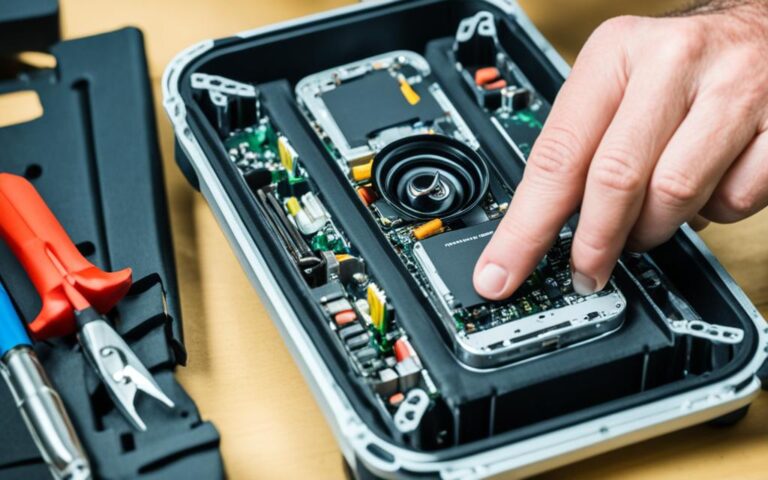Phone SIM Tray Replacement: A Simple Repair Guide
Welcome to our comprehensive guide on phone SIM tray replacement. Whether you’re experiencing a broken SIM card reader pin or need to change your SIM card, this step-by-step guide will walk you through the process. With easy-to-follow instructions and tips, you’ll be able to perform this simple repair at home with confidence.
At some point, you may find yourself in a situation where you need to replace your phone’s SIM tray. This could be due to a broken pin caused by using SIM card adapters or a need to switch to a new carrier or a damaged SIM card. Whatever the reason may be, our guide will provide you with all the information you need to successfully replace your SIM tray and restore proper functionality to your phone.
In this guide, we will cover the reasons for SIM tray replacement, the tools you will need for the repair, the process of removing the SIM card, how to replace the SIM tray, and the final steps for reassembling your device. We will also share some helpful tips and precautions to ensure a successful repair.
Follow along with our step-by-step instructions and you’ll have your phone’s SIM tray replaced in no time. Let’s get started!
Reasons for SIM Tray Replacement
There can be several reasons why you might need to replace your phone’s SIM tray. One common issue is a broken SIM card reader pin, which can happen when using SIM card adapters. Another reason is the need to change your SIM card due to a new carrier or a damaged SIM card. Whatever the reason, replacing the SIM tray can restore proper functionality to your device.
| Reasons for SIM Tray Replacement |
|---|
| Broken SIM card reader pin |
| Change of carrier |
| Damaged SIM card |
“A broken SIM card reader pin can prevent your device from detecting the SIM card, resulting in a loss of cellular connectivity. This often occurs when using SIM card adapters, which can put excessive pressure on the delicate pins. Replacing the SIM tray can resolve this issue and allow your device to read the SIM card correctly.”
“Changing your carrier or getting a new SIM card may require replacing the SIM tray. Different carriers may use different SIM card sizes, such as nano, micro, or standard SIM cards. In some cases, a damaged SIM card may also necessitate a SIM tray replacement to ensure a proper connection with the device.”
With a new SIM tray in place, you can enjoy uninterrupted connectivity and smoothly transition between carriers or SIM cards. Now that we’ve covered the reasons why a SIM tray replacement may be necessary, let’s move on to the tools needed for this repair.
Tools Needed for SIM Tray Replacement
Before you start replacing your phone’s SIM tray, it’s important to gather the necessary tools. Having the right tools on hand will ensure a smooth and successful SIM tray replacement. Here are the essential tools you’ll need:
- SIM-eject tool or small paperclip: A thin metal tool like a SIM-eject tool or a small paperclip is commonly used to remove the SIM card from the tray. This tool helps you safely eject the SIM card without damaging it or the tray.
- Product manual: Every phone model is unique, and the specific tools required for SIM tray replacement may vary. It’s crucial to consult your device’s product manual to determine the correct tools needed. The manual will provide you with detailed information on the recommended tools and the proper procedure for replacing the SIM tray.
Remember, using the correct tools is essential to prevent accidental damage to your device or SIM card during the replacement process. Always refer to the product manual for your specific phone model to ensure a successful SIM tray replacement.
Tools Needed for SIM Tray Replacement
| Tool | Description |
|---|---|
| SIM-eject tool or small paperclip | A thin metal tool used to safely remove the SIM card from the tray without causing any damage. |
| Product manual | A guide provided by the phone manufacturer that contains information on the specific tools required for SIM tray replacement, tailored to your phone model. |
Having the right tools will make the SIM tray replacement process much easier and ensure that you can complete the repair with confidence. Now that you have gathered the necessary tools, you’re ready to move on to the next steps of replacing the SIM tray.
Removing the SIM Card
The first step in removing the SIM card is an essential part of replacing the SIM tray in your phone. By carefully following specific instructions based on your phone model, you can successfully take out the SIM card and proceed with the repair process.
For some phones, you’ll require a SIM-eject tool or a small paperclip to push into a small hole next to the SIM tray and gently pop it out. Take caution and be gentle during this process to avoid damaging the SIM card or the tray.
In other cases, you may need to remove the back cover or the battery to access the SIM card. Refer to your phone’s user manual or manufacturer’s instructions for the proper method to remove the SIM card in your specific device.
Here’s an example of how to remove the SIM card using a SIM-eject tool:
- Locate the SIM tray on your phone. It is usually located on the side or top of the device.
- Insert the SIM-eject tool or a small paperclip into the small hole beside the SIM tray.
- Apply gentle pressure and push the tool in until the SIM tray pops out slightly.
- Gently pull out the SIM tray from the phone.
- Remove the SIM card from the tray by sliding it out or pressing it gently to release it.
Once you have successfully removed the SIM card, you can proceed with the next steps of replacing the SIM tray.
Important Note:
Be cautious when handling the SIM card and the SIM tray. Avoid touching the gold contacts on the SIM card to prevent static electricity damage. If you are unsure about the proper method to remove the SIM card or encounter any difficulties, it is recommended to seek professional assistance or refer to the manufacturer’s instructions.
Proceed to the next section to learn about replacing the SIM tray.
Replacing the SIM Tray
Once you have removed the SIM card, you can proceed with replacing the SIM tray. Carefully slide the new SIM tray into the device, making sure it fits smoothly and without force. If the tray feels loose, you can add tape or paper to secure it in place. Make sure to align the notch on the SIM card with the notch on the tray before reinserting it. Follow any specific instructions provided by the phone manufacturer for your particular model.
Here are the step-by-step instructions for replacing the SIM tray:
- Remove the old SIM tray from the phone.
- Take the new SIM tray and ensure it is compatible with your phone model.
- Hold the new SIM tray with the notch facing up.
- Carefully insert the SIM card into the new tray, aligning the notch on the card with the notch on the tray.
- Gently slide the tray back into the phone, ensuring it goes in smoothly.
- If the tray feels loose, secure it in place with tape or paper.
- Follow any additional instructions provided by the phone manufacturer to complete the process.
Remember to be gentle and patient while replacing the SIM tray to avoid causing any damage to your device. If you encounter any difficulties, consult the product manual or seek professional assistance.
Important Note:
It is crucial to ensure proper alignment between the SIM card and the SIM tray notch. Failing to align them correctly may result in the SIM card not being detected or causing damage to the card or tray. Take your time and double-check the alignment before reinserting the tray.
| Tools needed for SIM tray replacement: | |
|---|---|
| Thin metal tool (SIM-eject tool or small paperclip) | |
| Tape or paper (if needed to secure the tray) |
By following these instructions, you can successfully replace your phone’s SIM tray and ensure proper functionality of your SIM card. Remember to consult the product manual or seek professional help if you encounter any difficulties or if you are unsure about the process.
Reassembling the Device
After replacing the SIM tray, it’s crucial to reassemble your device correctly. This process includes carefully placing the battery back into its original position, ensuring a secure fit. Additionally, reattach the back cover firmly to protect the internal components. To successfully reassemble your device, follow the reverse order of disassembly, ensuring that all parts are positioned correctly.
Take care not to damage any fragile parts or cables during the reassembly process.
Tips for Reassembling Your Device:
- Double-check the alignment of all components before securing them in place.
- Be meticulous when handling delicate parts to prevent further damage.
- Refer to the product manual or online resources for any specific instructions or precautions regarding reassembly.
| Component | Actions |
|---|---|
| Battery | Place the battery back into the device, ensuring proper alignment and connection. |
| Back Cover | Securely reattach the back cover, ensuring it fits snugly and aligns with the device’s body. |
| Fragile Parts and Cables | Handle with care to avoid damaging any delicate parts or cables; pay attention to their proper positioning during reassembly. |
Once you have successfully reassembled your device, you can proceed to test its functionality. Power on the device and confirm that all features, including the SIM card recognition, are working correctly. If you encounter any issues, refer to the troubleshooting section in the product manual or seek professional assistance.
Tips and Precautions
When performing a SIM tray replacement, there are a few tips and precautions to keep in mind. Firstly, be gentle when handling delicate components to avoid causing further damage. It’s important to ensure proper alignment of the SIM card and the SIM tray notch before reinserting it to prevent any connectivity issues. Additionally, if your phone has a removable battery, make sure to follow the specific instructions provided by the manufacturer for removing and reinserting it safely.
Here are some further tips to consider:
- Before starting the replacement process, power off your phone to avoid any potential short circuits.
- Use a SIM-eject tool or a small paperclip to remove the SIM card from the tray gently.
- Double-check that the new SIM tray is compatible with your phone model to ensure a proper fit.
- When sliding the new tray into the device, do it slowly and steadily, ensuring it fits smoothly without any force.
- If the tray feels loose, consider using a small piece of tape or paper to secure it in place.
- After reassembling the device, test the SIM card functionality by powering it on and checking for signal reception.
Remember, if you encounter any difficulties during the SIM tray replacement process, it’s always recommended to consult the product manual for your specific phone model. Following these tips and precautions will help ensure a successful and hassle-free repair.
Conclusion
In conclusion, replacing a phone SIM tray is a relatively simple repair that can be done at home with the right tools and instructions. Whether you need to replace a broken SIM card reader pin or change your SIM card, following the step-by-step guide provided in this article will help you complete the repair with ease. It’s important to remember to take necessary precautions and consult the product manual for your specific phone model to ensure a successful SIM tray replacement.
By following the instructions outlined in this simple repair guide, you can save time and money by avoiding a costly professional repair. With just a few basic tools and a little bit of patience, you’ll have your phone’s SIM tray replaced in no time.
Don’t let a broken SIM card reader pin or the need to change your SIM card hold you back. Take control of your phone’s functionality and restore it to its full potential through a phone SIM tray replacement. Trust in your own capabilities and use this guide to complete the repair hassle-free.
FAQ
What are the reasons for SIM tray replacement?
The most common reason for SIM tray replacement is a broken SIM card reader pin, often caused by using SIM card adapters. Another reason is the need to change your SIM card, either due to a new carrier or a damaged SIM card.
What tools are needed for SIM tray replacement?
The necessary tools for SIM tray replacement may vary depending on the phone model. However, you will typically need a thin metal tool like a SIM-eject tool or a small paperclip. Consult your device’s product manual to ensure you have the correct tools on hand.
How do I remove the SIM card from my phone?
The process of removing the SIM card varies depending on your phone model. In some cases, you may need to use a SIM-eject tool or a small paperclip to push into a small hole next to the SIM tray and gently pop it out. For other phones, you may need to remove the back cover or the battery to access the SIM card.
How do I replace the SIM tray?
To replace the SIM tray, slide the new tray carefully into the device, ensuring a smooth and gentle fit. If the tray feels loose, you can secure it in place with tape or paper. Align the notch on the SIM card with the notch on the tray before reinserting it. Follow any specific instructions provided by the phone manufacturer for your particular model.
How do I reassemble the device after replacing the SIM tray?
When reassembling your device, make sure to place the battery back in if it was removed and reattach the back cover securely. Follow the reverse order of disassembly, ensuring all components are in their correct positions. Take care not to damage any fragile parts or cables during the reassembly process.
What tips and precautions should I keep in mind when performing a SIM tray replacement?
It is important to handle delicate components gently to avoid further damage. Ensure proper alignment of the SIM card and the SIM tray notch before reinserting the card. If your phone has a removable battery, follow the specific instructions for removing and reinserting it. Consult your device’s product manual for any specific precautions or recommendations.












